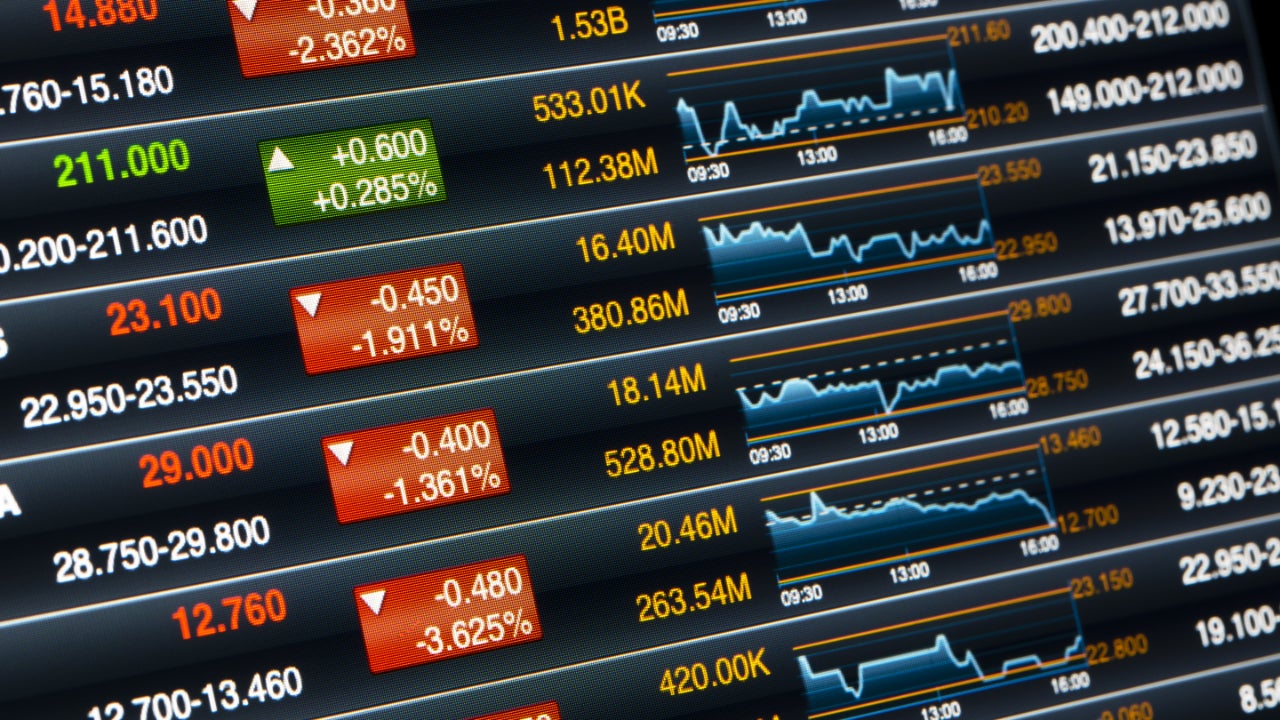What Teenagers Really Learn From Stock-Market Games
Successful investors diversify broadly, avoid unnecessary risk and rarely trade. So why are kids getting rewarded for doing the opposite?
Every year, more than a million high-school students across the U.S. learn about investing through stock-picking games. If you have teenagers, they may be playing this spring.
Proponents say these games are exciting and inspire an interest in investing.
We could make drivers’ education exciting, too, by teaching kids to run red lights and crash into brick walls. I suppose you could even argue that might make the survivors better drivers.
Of course, that isn’t how we teach teenagers to drive. Yet when it comes to investing and “financial literacy,” millions of teenagers learn what it’s like to take wild risks, using play money—often amplified with more fantasy money that they borrow—to fire off a barrage of fast trades in turbulent assets.
In the long run, investors who diversify broadly, avoid unnecessary risk and rarely trade are almost certain to do well. In these stock-market competitions, teenagers who behave like that are almost certain to lose.
Emma Freeman, a senior at Lewisburg Area High School in Lewisburg, Pa., won that state’s championship when she was in a ninth-grade economics class taught by Michael Creeger. She turned $100,000 in play money into more than $550,000 in 10 weeks. “I played it as if I was day trading,” she says.
Emma would look up which stocks had just risen the most, then sell them short so she could profit from a decline. “Anything that had jumped up like crazy, when it looked like just hype, we short-sold the crap out of it,” she says.
Emma traded up to 40 times a day. “My friends told me I looked like a madwoman,” she recalls. “I would be staring at the screen and making crazy faces and stuff because it was so intense.”
Last spring, another of Mr. Creeger’s ninth-grade economics students, Zachery Engle, won the state championship. He traded 117 times in 10 weeks.
Zach used about $200,000 in margin borrowing to drive his pretend portfolio up to $583,070. “It’s nice that they let you do that,” he says. “It makes it easier to make money.”
Or lose money—which is why Warren Buffett repeatedly warns investors not to use leverage.
Mark Brookshire, founder and chief executive of Stock-Trak Inc. of Montreal, which provides the stock simulation that Emma and Zach played, says more than 500,000 students participate in grades K-12. Most play only as part of a class, not in a wider competition.
Teachers can limit the number of trades, restrict margin or prohibit short selling. Outside of state-run contests, says Mr. Brookshire, only 14% of teachers permit margin—so most portfolios aren’t leveraged. Over the typical 10-week course, the average student makes 22 trades.
“Anybody who can turn $100,000 into $200,000 in 10 weeks with what they learned in their high-school class is just lucky,” says Mr. Brookshire. “The next 10 weeks they probably won’t be so lucky. That will be the lesson, that the more you do it, the more likely you’re going to lose. I want them to lose my virtual money before they lose their own real money.”
Ryan Monoski, a former business teacher at Montgomery High School in Montgomery, Pa., has come to doubt that lesson.
In 2016 and 2017, his teams won the national championship in the Capitol Hill Challenge, a stock-picking competition run by the Sifma Foundation, a nonprofit supported by the brokerage industry. His teams also won Pennsylvania’s state championship at least a dozen times.
All these contests “motivate students to take extreme risks that will bring extreme rewards and extreme losses, and that’s not the right way to invest,” says Mr. Monoski, who now runs a stock-picking channel on YouTube.
Like teams from other schools, Mr. Monoski’s students often borrowed money to sell short. They used 50% margin to buy explosively volatile triple-leveraged exchange-traded funds, magnifying daily market moves 4.5-fold.
The Capitol Hill Challenge no longer allows any of that.
However, sessions of the Sifma Foundation’s Stock Market Game, run in all 50 states and played by 600,000 children annually, may permit selling short and borrowing on margin. Teams often own as few as five stocks at a time, not nearly enough diversification by prudent investing standards.
“It’s important to recognize that the simulation plays a small part,” says Melanie Mortimer, president of the Sifma Foundation. “The real focus is the curriculum, which is all about the fundamentals of investing and the capital markets.”
Richard Daly, the foundation’s chairman, says the organization shares concerns that the game might teach children to take too much risk. But, he says, “we don’t want to lose the greater good of all the kids we’re touching that otherwise wouldn’t be exposed” to the stock market at all.
My drivers’ ed teacher taught me to put safety first, and yours probably did, too. That’s what children learning how to invest should be rewarded for. They shouldn’t be proclaimed “winners” for taking huge risks that could encourage a lifetime of bad behaviour.
Reprinted by permission of The Wall Street Journal, Copyright 2021 Dow Jones & Company. Inc. All Rights Reserved Worldwide. Original date of publication: March 25, 2022.
This stylish family home combines a classic palette and finishes with a flexible floorplan
Just 55 minutes from Sydney, make this your creative getaway located in the majestic Hawkesbury region.
Impact investing is becoming more mainstream as larger, institutional asset owners drive more money into the sector, according to the nonprofit Global Impact Investing Network in New York.
In the GIIN’s State of the Market 2024 report, published late last month, researchers found that assets allocated to impact-investing strategies by repeat survey responders grew by a compound annual growth rate (CAGR) of 14% over the last five years.
These 71 responders to both the 2019 and 2024 surveys saw their total impact assets under management grow to US$249 billion this year from US$129 billion five years ago.
Medium- and large-size investors were largely responsible for the strong impact returns: Medium-size investors posted a median CAGR of 11% a year over the five-year period, and large-size investors posted a median CAGR of 14% a year.
Interestingly, the CAGR of assets held by small investors dropped by a median of 14% a year.
“When we drill down behind the compound annual growth of the assets that are being allocated to impact investing, it’s largely those larger investors that are actually driving it,” says Dean Hand, the GIIN’s chief research officer.
Overall, the GIIN surveyed 305 investors with a combined US$490 billion under management from 39 countries. Nearly three-quarters of the responders were investment managers, while 10% were foundations, and 3% were family offices. Development finance institutions, institutional asset owners, and companies represented most of the rest.
The majority of impact strategies are executed through private-equity, but public debt and equity have been the fastest-growing asset classes over the past five years, the report said. Public debt is growing at a CAGR of 32%, and public equity is growing at a CAGR of 19%. That compares to a CAGR of 17% for private equity and 7% for private debt.
According to the GIIN, the rise in public impact assets is being driven by larger investors, likely institutions.
Private equity has traditionally served as an ideal way to execute impact strategies, as it allows investors to select vehicles specifically designed to create a positive social or environmental impact by, for example, providing loans to smallholder farmers in Africa or by supporting fledging renewable energy technologies.
Future Returns: Preqin expects managers to rely on family offices, private banks, and individual investors for growth in the next six years
But today, institutional investors are looking across their portfolios—encompassing both private and public assets—to achieve their impact goals.
“Institutional asset owners are saying, ‘In the interests of our ultimate beneficiaries, we probably need to start driving these strategies across our assets,’” Hand says. Instead of carving out a dedicated impact strategy, these investors are taking “a holistic portfolio approach.”
An institutional manager may want to address issues such as climate change, healthcare costs, and local economic growth so it can support a better quality of life for its beneficiaries.
To achieve these goals, the manager could invest across a range of private debt, private equity, and real estate.
But the public markets offer opportunities, too. Using public debt, a manager could, for example, invest in green bonds, regional bank bonds, or healthcare social bonds. In public equity, it could invest in green-power storage technologies, minority-focused real-estate trusts, and in pharmaceutical and medical-care company stocks with the aim of influencing them to lower the costs of care, according to an example the GIIN lays out in a separate report on institutional strategies.
Influencing companies to act in the best interests of society and the environment is increasingly being done through such shareholder advocacy, either directly through ownership in individual stocks or through fund vehicles.
“They’re trying to move their portfolio companies to actually solving some of the challenges that exist,” Hand says.
Although the rate of growth in public strategies for impact is brisk, among survey respondents investments in public debt totaled only 12% of assets and just 7% in public equity. Private equity, however, grabs 43% of these investors’ assets.
Within private equity, Hand also discerns more evidence of maturity in the impact sector. That’s because more impact-oriented asset owners invest in mature and growth-stage companies, which are favored by larger asset owners that have more substantial assets to put to work.
The GIIN State of the Market report also found that impact asset owners are largely happy with both the financial performance and impact results of their holdings.
About three-quarters of those surveyed were seeking risk-adjusted, market-rate returns, although foundations were an exception as 68% sought below-market returns, the report said. Overall, 86% reported their investments were performing in line or above their expectations—even when their targets were not met—and 90% said the same for their impact returns.
Private-equity posted the strongest results, returning 17% on average, although that was less than the 19% targeted return. By contrast, public equity returned 11%, above a 10% target.
The fact some asset classes over performed and others underperformed, shows that “normal economic forces are at play in the market,” Hand says.
Although investors are satisfied with their impact performance, they are still dealing with a fragmented approach for measuring it, the report said. “Despite this, over two-thirds of investors are incorporating impact criteria into their investment governance documents, signalling a significant shift toward formalising impact considerations in decision-making processes,” it said.
Also, more investors are getting third-party verification of their results, which strengthens their accountability in the market.
“The satisfaction with performance is nice to see,” Hand says. “But we do need to see more about what’s happening in terms of investors being able to actually track both the impact performance in real terms as well as the financial performance in real terms.”
This stylish family home combines a classic palette and finishes with a flexible floorplan
Just 55 minutes from Sydney, make this your creative getaway located in the majestic Hawkesbury region.


















